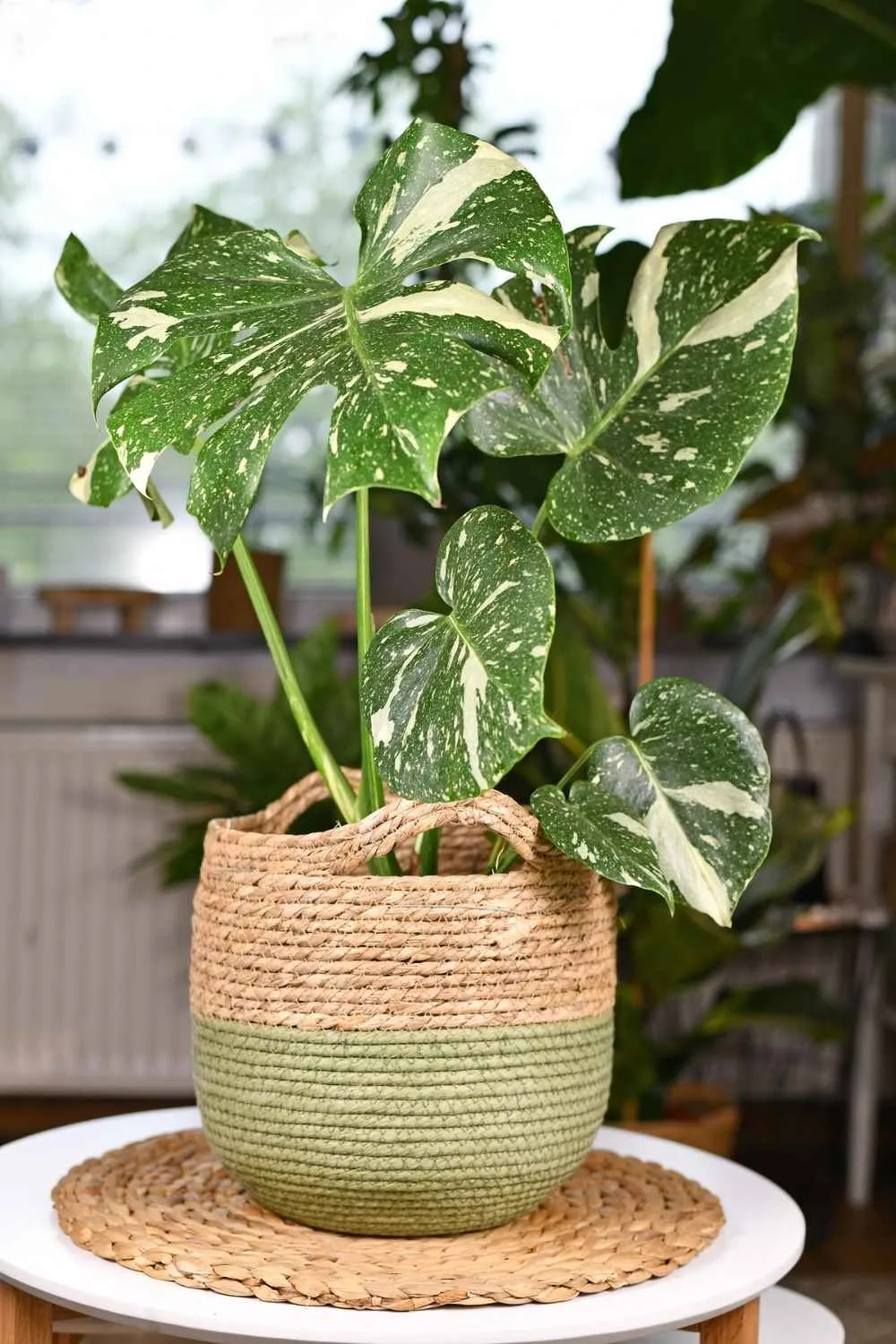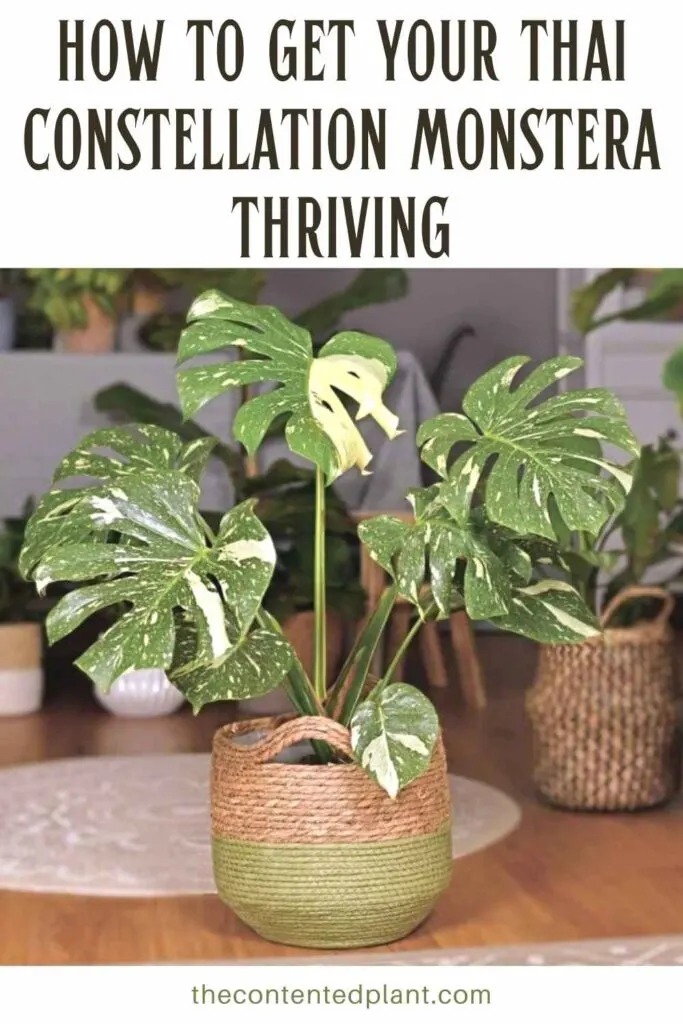Thai constellation monstera is a stunning variegated version of the Monstera Deliciosa. These are large showy plants that grow six to eight feet. Plan to give these splashy beauties room to grow.
Monstera Thai Constellation plants have splits in the leaves called leaf fenestrations like the Deliciosa. And in plant form and size they are identical.
Thai Constellation does require more light than the mother Deliciosa. Those stunning variegations on the leaves require good light for expression.
Every one of those splashy white or cream spots is a place the plant leaf CANNOT photosynthesize.
Give the monstera Thai constellation bright indirect light. It processes the light to feed the plant.
Side note: The plant also needs bright indirect light (although not as much) to create its best fenestrations. Put the Thai in a corner window with lots of filtered light and it will be a happy houseplant.
If you don’t have a large corner window, turn the plant a half or quarter turn when you water.
This will keep the light even on all the leaves for a well balanced variegation and overall best plant shape.

Thai Constellation Variegation:
The Thai Constellation is one of several variegated Monsteras. All variegated forms of Deliciosa Monstera Plants are stunning.
Monstera variegation is different in look and how it is developed from plant to plant. Most of the variegated monsteras are cuttings from the Borsigiana monstera( a sub group of Deliciosa).
Some forms come from a seed color mutation. These wild color mutations are VERY rare. So they are expensive. Like the Monstera Deliciosa Albo Variegata.
Monstera Adonsonii variegations are even more rare. If you find one expect to pay BIG.
Fortunately, Thai Constellation is easier to find and less expensive than the more rare forms. Thai Constellation variegation is made from a stable tissue culture. The color mutation can easily be propagated over and over again.
However, At this time it is still several hundred dollars for a small plant.
But once Costa farms releases it in 2022 the price should drop. Fingers crossed! For now, you can find a few Thai Constellations on Etsy.
Read our care guide below to see how simple it really is to care for this plant. Thai Constellation Monsteras are pretty tough.
They make great indoor plants. you just need to give them proper care.
Monstera Thai Constellation Care Guide

The Monstera Thai Constellation is a large lovely variegated Monstera plant. Beautiful splashes of white and yellow on its fenestrated leaves add interest and texture to this magnificent plant.
This Care Guide will teach you how to keep this houseplant happy all through the year.
Materials
- Orchid bark
- Peat moss
- Perlite
- General potting soil
- mask
- Fertilizer
Tools
- Pot (ceramic, plastic, or terra cotta)
- Potting medium (perlite, soil, peat moss, and orchid bark)
- Scissors
- Rubbing Alcohol
Instructions
Soil Preference:
- All Monsteras prefer well draining soil. The roots require lots of oxygen and will rot quickly if they sit in moist soil.
- A homemade aroid soil mix of 1/2 potting soil and 1/2 peat moss or coco fiber is a good mix for monsteras. Add bark or perlite for an even lighter mix.
- Make sure your pot has drainage at the bottom. Do not use a pot with no drainage hole for this plant.
- A heavy soil potting mix is not recommended for Monsteras
Pot Size and Type:
- The monstera Thai Constellation can grow in many different kinds of pots, I like to plant mine in terra cotta pots with a drainage hole.
- Monsteras do not like to be root bound
- Repot every second year or when roots come out the drainage holes on the pot bottom. Don't jump to a huge pot from a small one. Just go to the next size up pot for the root ball. Too much soil around the root ball invites wet soil conditions and root rot will follow.
Moss Poles and Trellising:
- Your Deliciosa Thai Constellation will enjoy growing on a moss pole so it can be fed and moisturized as it climbs. This will give you both excellent leaf growth and plant size. Eventually you will need a well anchored good sized pole.
Lighting:
- This monstera will be happiest in BRIGHT indirect light. It will also grow just fine in lower light conditions. But the growth will be slower and the leaf fenestrations and variegation will not be as good.
- Bright filtered sunlight from a window will produce best color, leaf size and plant growth.
- Make sure the plant isn't sitting in constant direct sunlight. The leaves can burn and yellow.
Watering:
- Water your monstera when the soil is dry at least an inch down. These aroid plants are typically drought resistant and can withstand longer periods of dryness compared to other houseplants. Every two weeks should be fine.
- Watering is best done on a regular schedule so the plant is not over or under watered. Both can cause stress on the plant.
- In dormant winter months reduce watering to when the soil is dry.
- Never let this plant get wet feet. This plant is susceptible to root rot and fungus gnats in heavy moist soils.
Humidity Tips:
- Like all monstera the Deliciosa Thai Constellation enjoys a humid environment. Keep the plant at 60% humidity or higher for best growth and hydration. Here are some ways to do that.
- Set it on a large pebble tray with water in it.
- give your plant room a good sized humidifier.
- Group plants together so they respire together and keep the humidity up.
- Use a hygrometer to monitor the humidity and check it often.
How to Fertilize:
- Apply a good quality fertilizer (linked in materials) monthly through Spring and summer.
- Decrease feedings by late Fall and allow this plant to rest through the winter months.
Temperature:
- The monstera plant will do best in temperatures between 65-85 degrees F.
Leaf Washing:
- Monstera plants benefit from monthly leaf washing to dust and pests off. This also open the leaf stomata so the leaf can absorb moisture and respire oxygen to your room.
- 1 1/2 Tsp. Neem oil to a quart of distilled water is a good solution for applying directly to the leaves to deter pests. Wash both the top and bottom of the leaf.
Pests:
- This monstera is a hardy resilient plant. However all plants can get attacked by pests.
- Stress by longterm overwatering, poor light, extreme temperatures and soil conditions are contributors to plant stress..
- Spider mites, mealy bugs, scale, thrips and whitefly are the most common houseplant pests you will see.
- Read our post on How to get rid of aphids and other pests with our homemade pesticide soap recipe or neems oil.
- To minimize the possibility of pests be sure to check all nursery plants before bringing them home.
- Quarantine all new plants until you are sure no pests live in them.
How to Propagate:
- Stem Cuttings:
- Cut stem in the internodal spacing using sterile scissors
- Place in water or wet spagnum moss with nodes and stem down in the water or moss and the leaf up.
- After several weeks roots will grow
- Plant in soil when roots are 2-3 inches long
- Planting From Seed:
- Read my post and watch my video series on how to propagate monstera from seeds.
- Toxic Plant Warning:
- All Monstera plants are toxic. Keep them away from kids and pets.
Notes
This plant does best when trained onto a moss pole or trellis so it can climb. Watch the video below of us repotting and staking our raphidophora tetrasperma for tips on repotting climbing aroids.
Follow Us:
Find us on YouTube, Instagram , Pinterest and TikTok! We love to Plant chat. We also comment, like and occasionally share your content to our daily stories. We’d love to see your plants. Share your joy in your houseplants. Happy Planting!


How to Keep your Houseplants Alive In Winter - The Contented Plant
Sunday 9th of January 2022
[…] leaves will help increase humidity. Larger tropical plants like the money tree, Ficus benjamina and Thai Constellation Monsteras can be given occasional showers to clean and hydrate the leaves. (keep succulents leaves […]